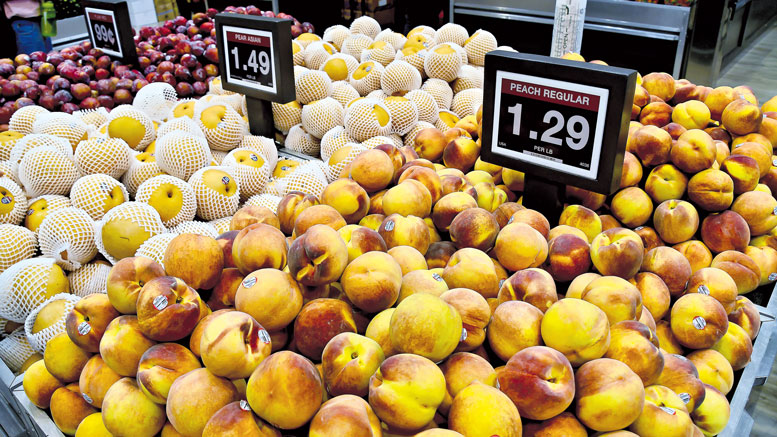Peaches Flavor Fall Events
July 29, 2024 | 9 min to read
As peach season winds down, late varieties shine with unique features. Family-owned Peters Orchards thrives on optimal ripening, showcasing varieties like Sweet Dream and Autumn Flame. Innovations in organic farming, such as pathogen-killing technology, enhance production. Despite challenges like spring freezes affecting harvests, growers anticipate a positive outlook for crops through September. Retail strategies emphasize appealing displays, focusing on freshness and local sourcing, engaging consumers who prioritize quality and convenience in their peach selections.

As the end of peach season nears, late varieties demonstrate captivating qualities.
Fall means back to school with lunch boxes and after-school snacks, Labor Day cookouts, parades, and end-of-summer community events. Whether eating out of hand or exploring tastes in easily prepared dishes, with their visual appeal, enticing aroma, and scope of flavors, peaches are a feast not to be missed in fall celebrations.
LATE VARIETIES DRIVE THE FALL MARKET
As the end of the peach season approaches, numerous late varieties demonstrate this fruit’s captivating qualities.
Family-owned and operated since 1870, Peters Orchards, Gardners, PA, in the heart of Pennsylvania’s apple country, grows almost 40 different peach varieties. White and yellow, clingstone and freestone, heirloom, donut and sub-acid varieties are included.
“Because we grow all our own peaches, we can let them tree-ripen and pick them at optimal sweetness. During the peach season in July-September, we hand pick daily,” says David Peters, owner.
Peters explains, “Each peach variety lasts only a short period of time.”
He adds that weather influences variety availability. The unique sub-acid, semi-cling, large, firm, highly colored Sweet Dream should be available in August, while the yellow Elberta, Autumn Glo and Autumn Star, all large and famous for multiple uses, mature in September. Also, freestone Laurol and Victoria, both with yellow flesh, red or red-blushed skin, along with the white-fleshed, delicately flavored Snow Giant, produce first-rate September peaches.
“Stay tuned for our organic August Flame yellow peach in August. It is colorful, delicious, and healthy to eat,” says Kira Navison, director of marketing, Scattaglia Growers and Shippers, Kingsburg, CA.
“Our organic growers have installed an Aweta sizer that specializes in consistency from one piece of fruit to the next when it comes to size, color and flavor. Along with this, we are utilizing Clean Works, a new technology that helps kill pathogens such as E. coli, salmonella, listeria and more, as well as increases the shelf life of the fruit. We are the only company in the U.S. utilizing this technology for organic stone fruit.”
Grower, packer, shipper HMC Farm, Kingsburg, CA, produces peaches from early May to late September. Chief Executive Officer Harold McClarty contrasts this season to last year, and says it’s going to be fine.
For late fall, he calls attention to their yellow-flesh, red-skin Autumn Flame, which easily brightens any produce assortment with its classic, old-fashioned mildly acidic flavor. Five-generation HMC Farms grows nectarines and plumsicles on their 6,000 acres, noted for their solar power and their efficient water usage, and adaptation to precision irrigation. All HMC peaches are grown in California’s Central Valley.
When domestic peaches are out of season, imports fill the gaps. Karen Brux, managing director of Chilean Fresh Fruit Association, Redwood City, CA, says, “We start shipping in late fall. Supplies are minimal in mid-November. By early December, you can see peaches from Chile in the grocery stores.”

DEAN BARNES/PRODUCE BUSINESS PHOTO
Peaches are grown in over half of the U.S. states. But the big producers are California, South Carolina, Georgia, Pennsylvania, New Jersey, Colorado and Michigan. Last year, 46% of production was for clingstone peaches, which are primarily processed. The 54% balance of freestone production was for the fresh market.
As home peach canners are aware, flesh slips easily from the stone for freestone peaches. Commercial canners mechanically separate the flesh stuck to the pit in clingstones.
The U.S. Department of Agriculture classifies the freestone season as April 20 to Oct. 10 for California, May to August for Georgia and South Carolina, and July to September for all other states.
“Consumers typically prefer freestone peaches. Processors use clingstone varieties, although some early consumer varieties are clingstone types,” says Nettie Hurry, product development and sales manager, Adams County Nursery, Aspers, PA.
Adams County Nursery lists white peaches, August Rose, Blushing Star, Snow Giant, and September Rose, as ripening from late August to late September. “White varieties are lower acid, and the flavor is complex,” says Hurry.
New yellow peaches identified by Hurry that ripen later are Selena and Tiana. Other familiar varieties with September maturities handled by them include the varieties Peters grows.
The New Jersey Department of Agriculture (NJDA), in last season’s release says, “The Encore and Laurol varieties wrap up the state’s peach season in mid- to late-September. White peaches are expected to begin shipping around the end of July and continue through mid-September.”
Dixie Belle Peaches, Ridge Spring, SC, indicates their later peach varieties this season would include Summer Lady, August Prince, Monroe, Tyler and Snow Giant.
Sierra Gold Nurseries, Yuba City, CA, lists large yellow with red-blushed skin, Fayette, and Summerset, also a sweet large, late-ripening variety. Sales representative Melissa Brocke reports, “Clingstone varieties tend to be earlier and sweeter than freestone ones.” She adds, “Customers look for firmness and color, and full of nutrients.”
Brandt Farms, Reedley, CA, indicates that their Red October, a clingstone variety, has an intense, sweet, traditional peach flavor with high juice. With red and gold skin, the texture is non-mealy. Brandt Farms’ mid-September harvest is available in October.
Wholesaler-distributor Sunny Valley International, Glassboro, NJ, ships stone fruits from the Southeast and New Jersey from mid-June to mid-September through multiple East Coast shipping points. As a full-service marketer of domestic and imported fruit, they offer support 12 months per year. Size and color sorters, tracing software, plus repacking and styling services are employed to assure fruit quality.
Tom Beaver, director of sales and marketing, points out the advantages of their location. “Our products are picked and transported to reach their destinations within 24 hours,” he says. In some instances, it may be one more day, but contrasted with shipments from California that could be four days. Beaver notes, “Mid-Atlantic grocers will receive the best quality.”
Beaver says Sunny Valley’s peaches are ripened and handled well. “South Carolina and New Jersey provide a continual supply. They catch the eye. In late summer, they can be an impulse buy. They are a beautiful piece of fruit — they have a captive, decadent dessert quality, and appeal to all senses.”
Regarding new varieties, Beaver reports, “It’s something we’re continuing to focus on with our grower-partners, both domestically and abroad. The key is finding varieties that are adequately tailored to the unique environmental conditions in different growing regions. For example, high chill varieties that perform well in New Jersey’s sandy acidic soil are not suited for arid regions of Peru.”
Professor Edgar Vinson, Auburn University, Auburn, AL, explains, “Peaches enjoyed in summer develop from the chilly temperatures from the previous winter. Depending on the variety, peach development requires temperatures of 45 degrees Fahrenheit and below for anywhere from 600 to 1,000 hours, or chill hours.”
Different varieties require different chill requirements.
Vinson further elaborates that due to warming trends, regions that previously received 1,200 hours now receive 750. Those bred to require higher chill can now struggle to produce fruit, become weak, and over time their longevity will shorten. Peach growers not only need specific chill-hour trees, but spring freezes can permanently damage the fruit. Extension service reports speculate that last year Georgia lost about 90% of the crop, and South Carolina lost 70 to 75% due to freezing temperatures in the spring.
“We’re now looking for 600 to 800 chill hours,” says Dr. Ksenija Gasic, peach breeding program director, Clemson University, Clemson, SC.
She explains the breeding efforts are very complicated by requiring targeted accumulated chill hours, yet being able to achieve the bloom timing to produce a fruitlet tolerant to freezing, plus desirable yield and quality.
This year, however, her program efforts were awarded two patents and one pending patent for her varieties.
EveResRuby, a freestone, has low acid, is consistently firm, and has an excellent eating quality. CaroResWonder, with good bud density, softens slowly, and has excellent eating quality at 10 brix. A freestone, it requires only 500 chill hours. Clingstone CaroResDelight, with 90% blush, is firm, round, large and flavorful.
THIS YEAR LOOKS POSITIVE
During this season, reports, during June in the growing regions, indicate good crops.
“Our growers are expecting a full crop of yellow and white peaches and nectarines from now through Labor Day, and the New Jersey Department of Agriculture stands by them to help promote availability of their products,” says Joe Atchison III, NJDA assistant secretary and director of marketing and development, Trenton, NJ.
Blakely Atkinson, marketing specialist, watermelon, peach and seafood, South Carolina Department of Agriculture, Columbia, SC, says, this year’s crop is up.
“The South Carolina Peach Council has been putting up new signs in 180 different stores. These stores are up and down the East Coast including Florida, and they also go to Arizona and Texas. This team is creating buyers and sales,” she says.
Facebook and Instagram highlight the social media presence.
“We use the ‘South Carolina is the tasty peach state’ slogan,” says Atkinson. “Last year radio stations ran ads during August National Peach Month until September.”
She emphasizes that consumers like to know where their food is coming from, and they prefer local food.
Noting what consumers look for in peaches, Atkinson responds, “Color, and they love round peaches.”
“Display matters — retailers should carefully place peaches in baskets with their tips up.”
— Blakely Atkinson, South Carolina Department of Agriculture, Columbia, SC
She adds, “Display matters — retailers should carefully place peaches in baskets with their tips up.”
Regarding packaging, she advises, “Consumers like hand-held packages, such as grab-and-go totes. Smaller boxes also do well for us, and clamshells are popular.”
She adds that consumers dislike large packages.
RETAILERS LIKE DISPLAYS
Ashley Bentey, produce manager in the Stillwater, OK, Homeland Grocery store, says, “We display peaches on tables, mostly with other fruit.”
Nectarines, lemons and limes bolster the color contrast with the yellow peaches.
Customers often ask where the product comes from. Homeland Grocery uses the peaches’ shipping boxes as part of the display. For example, Big Smile’s peach boxes denote South Carolina, which clearly designates that region.
To accompany the customers interested in convenience and grilling peaches, Bentey suggests the store’s new produce item — grill-ready marinated veggies. She says, “We have sales often, particularly during holiday events.”

AIMEE TENZEK/PRODUCE BUSINESS PHOTO
The County Market store on South Dirksen Parkway in Springfield, IL, creates highly visible displays of peaches in the produce department. They complement the store ads, which feature California peaches and nectarines, plus Southern peaches, both sold by the pound. Arrangements of the shipping boxes hold the displays.
To further sales, produce manager Jacob Brenner says, “We cut the peaches in half, which shows how they look inside.”
Customers can enjoy the aroma and taste as well. “They look for a nice color and juiciness,” he adds.
With 28 stores in Illinois, County Market, Quincy, IL, has two stores in Indiana and four in Missouri.

